On the Redox-Activity and Health-Effects of Atmospheric Primary and Secondary Aerosol: Phenomenology
Abstract
:1. Introduction
2. Materials and Methods
2.1. Measurement Sites and Observational Periods
2.2. Aerosol and Meteorological Field Measurements
2.2.1. PM1 Mass and Chemical Composition—Daily Samples Characterization
2.2.2. Non-Refractory PM1 Chemical Components (AMS)
2.2.3. Elemental Composition (STRAS)
2.2.4. Particle Number Size Distributions
2.2.5. Absorption and Scattering Coefficients (Aethalometer, PAX, DBAP, Filters)
2.2.6. EC and OC—Online Measurements
2.2.7. Micrometeorology
2.3. Toxicological Assessment
2.3.1. Oxidative and Reducing Potential
2.3.2. Filter-Based Toxicological Assays
2.3.3. Air Liquid Interface
2.4. Forecast Modeling System
3. Results
3.1. Meteorological Overview
3.1.1. Meteorology of IOPs
3.1.2. Micrometeorology during the SIOPs
3.2. Atmospheric Aerosol Properties
3.3. Oxidative and Reducing Potential
3.4. Toxicological Assessment
3.4.1. Effects of PM1 from Water-Extracted Samples during IOPs
3.4.2. Effects in Cells Exposed at the Air Liquid Interface during SIOPs
4. Discussion and Conclusions
- high values of PM1 mass concentration do not necessarily translate into high toxicity (i.e., PM1 mass concentration > 50 μg m−3 ), and conversely, very low values of PM1 (mass concentration < 5 μg m−3 ) do not necessarily translate into no toxicity;
- high values of BC mass concentration do not necessarily translate into high toxicity (BC mass concentration > 5 μg m−3);
- different WSOP assays may give different responses, but in general, high values of WSOP do not necessarily translate into high toxicity.
- Source apportionment of PM1 and the role of source emissions on aerosol toxicity;
- OP as a predictive variable for PM1 toxicity with a focus on SOA possessing redox-active capacity;
- Exposure-response relationships for PM1;
- Air quality models to forecast PM1 toxicity.
Supplementary Materials
Author Contributions
Funding
Data Availability Statement
Conflicts of Interest
References
- World Health Organization; WHO European Centre for Environment. WHO Global Air Quality Guidelines: Particulate Matter (PM2.5 and PM10), Ozone, Nitrogen Dioxide, Sulfur Dioxide and Carbon Monoxide; World Health Organization: Geneva, Switzerland, 2021.
- Chen, J.; Hoek, G. Long-term exposure to PM and all-cause and cause-specific mortality: A systematic review and meta-analysis. Environ. Int. 2020, 143, 105974. [Google Scholar] [CrossRef] [PubMed]
- Stafoggia, M.; Oftedal, B.; Chen, J.; Rodopoulou, S.; Renzi, M.; Atkinson, R.W.; Janssen, N.A. Long-term exposure to low ambient air pollution concentrations and mortality among 28 million people: Results from seven large European cohorts within the ELAPSE project. Lancet Planet. Health 2022, 6, e9–e18. [Google Scholar] [CrossRef]
- Li, X.; Jin, L.; Kan, H. Air pollution: A global problem needs local fixes. Nature 2019, 570, 437–439. [Google Scholar] [CrossRef] [PubMed] [Green Version]
- Künzi, L.; Krapf, M.; Daher, N.; Dommen, J.; Jeannet, N.; Schneider, S.; Geiser, M. Toxicity of aged gasoline exhaust particles to normal and diseased airway epithelia. Sci. Rep. 2015, 5, 11801. [Google Scholar] [CrossRef] [PubMed] [Green Version]
- Jimenez, J.L.; Canagaratna, M.R.; Donahue, N.M.; Prevot, A.S.H.; Zhang, Q.; Kroll, J.H.; Worsnop, D.R. Evolution of organic aerosols in the atmosphere. Science 2009, 326, 1525–1529. [Google Scholar] [CrossRef] [PubMed]
- Ervens, B.T.B.W.R.; Turpin, B.J.; Weber, R.J. Secondary organic aerosol formation in cloud droplets and aqueous particles (aqSOA): A review of laboratory, field and model studies. Atmos. Chem. Phys. 2011, 11, 11069–11102. [Google Scholar] [CrossRef] [Green Version]
- Corsini, E.; Ozgen, S.; Papale, A.; Galbiati, V.; Lonati, G.; Fermo, P.; Marinovich, M. Insights on wood combustion generated proinflammatory ultrafine particles (UFP). Toxicol. Lett. 2017, 266, 74–84. [Google Scholar] [CrossRef]
- Corsini, E.; Vecchi, R.; Marabini, L.; Fermo, P.; Becagli, S.; Bernardoni, V.; Marinovich, M. The chemical composition of ultrafine particles and associated biological effects at an alpine town impacted by wood burning. Sci. Total Environ. 2017, 587, 223–231. [Google Scholar] [CrossRef]
- Marabini, L.; Ozgen, S.; Turacchi, S.; Aminti, S.; Arnaboldi, F.; Lonati, G.; Marinovich, M. Ultrafine particles (UFPs) from domestic wood stoves: Genotoxicity in human lung carcinoma A549 cells. Mutat. Res. Genet. Toxicol. Environ. Mutagenesis 2017, 820, 39–46. [Google Scholar] [CrossRef]
- Costabile, F.; Alas, H.; Aufderheide, M.; Avino, P.; Amato, F.; Argentini, S.; Gobbi, G.P. First results of the “Carbonaceous aerosol in Rome and Environs (CARE)” experiment: Beyond current standards for PM10. Atmosphere 2017, 8, 249. [Google Scholar] [CrossRef] [Green Version]
- Gualtieri, M.; Grollino, M.G.; Consales, C.; Costabile, F.; Manigrasso, M.; Avino, P.; Zanini, G. Is it the time to study air pollution effects under environmental conditions? A case study to support the shift of in vitro toxicology from the bench to the field. Chemosphere 2018, 207, 552–564. [Google Scholar] [CrossRef] [PubMed]
- Kelly, F.J.; Fussell, J.C. Size, source and chemical composition as determinants of toxicity attributable to ambient particulate matter. Atmos. Environ. 2012, 60, 504–526. [Google Scholar] [CrossRef]
- Lakey, P.S.; Berkemeier, T.; Tong, H.; Arangio, A.M.; Lucas, K.; Pöschl, U.; Shiraiwa, M. Chemical exposure-response relationship between air pollutants and reactive oxygen species in the human respiratory tract. Sci. Rep. 2016, 6, 32916. [Google Scholar] [CrossRef]
- Saffari, A.; Daher, N.; Shafer, M.M.; Schauer, J.J.; Sioutas, C. Global perspective on the oxidative potential of airborne particulate matter: A synthesis of research findings. Environ. Sci. Technol. 2014, 48, 7576–7583. [Google Scholar] [CrossRef] [PubMed]
- Decesari, S.; Sowlat, M.H.; Hasheminassab, S.; Sandrini, S.; Gilardoni, S.; Facchini, M.C.; Sioutas, C. Enhanced toxicity of aerosol in fog conditions in the Po Valley, Italy. Atmos. Chem. Phys. 2017, 17, 7721–7731. [Google Scholar] [CrossRef] [Green Version]
- Verma, V.; Fang, T.; Xu, L.; Peltier, R.E.; Russell, A.G.; Ng, N.L.; Weber, R.J. Organic aerosols associated with the generation of reactive oxygen species (ROS) by water-soluble PM2.5. Environ. Sci. Technol. 2015, 49, 4646–4656. [Google Scholar] [CrossRef]
- Janssen, N.A.; Yang, A.; Strak, M.; Steenhof, M.; Hellack, B.; Gerlofs-Nijland, M.E.; Cassee, F. Oxidative potential of particulate matter collected at sites with different source characteristics. Sci. Total Environ. 2014, 472, 572–581. [Google Scholar] [CrossRef] [Green Version]
- Sarti, E.; Pasti, L.; Rossi, M.; Ascanelli, M.; PAgnoni, A.; Trombini, M.; Remelli, M. The composition of PM1 and PM2.5 samples, metals and their water soluble fractions in the Bologna area (Italy). Atmos. Pollut. Res. 2015, 6, 708–718. [Google Scholar] [CrossRef] [Green Version]
- Vecchi, R.; Marcazzan, G.; Valli, G.; Ceriani, M.; Antoniazzi, C. The role of atmospheric dispersion in the seasonal variation of PM1 and PM2.5 concentration and composition in the urban area of Milan (Italy). Atmos. Environ. 2004, 38, 4437–4446. [Google Scholar] [CrossRef]
- Amato, F.; Alastuey, A.; Karanasiou, A.; Lucarelli, F.; Nava, S.; Calzolai, G.; Querol, X. AIRUSE-LIFE+: A harmonized PM speciation and source apportionment in five southern European cities. Atmos. Chem. Phys. 2016, 16, 3289–3309. [Google Scholar] [CrossRef] [Green Version]
- Ricciardelli, I.; Bacco, D.; Rinaldi, M.; Bonafè, G.; Scotto, F.; Trentini, A.; Poluzzi, V. A three-year investigation of daily PM2.5 main chemical components in four sites: The routine measurement program of the Supersito Project (Po Valley, Italy). Atmos. Environ. 2017, 152, 418–430. [Google Scholar] [CrossRef]
- Gilardoni, S.; Massoli, P.; Paglione, M.; Giulianelli, L.; Carbone, C.; Rinaldi, M.; Facchini, M.C. Direct observation of aqueous secondary organic aerosol from biomass-burning emissions. Proc. Natl. Acad. Sci. USA 2016, 113, 10013–10018. [Google Scholar] [CrossRef] [Green Version]
- Lucarelli, F.; Calzolai, G.; Chiari, M.; Giardi, F.; Czelusniak, C.; Nava, S. Hourly elemental composition and source identification by Positive Matrix Factorization (PMF) of fine and coarse particulate matter in the high polluted industrial area of Taranto (Italy). Atmosphere 2020, 11, 419. [Google Scholar] [CrossRef] [Green Version]
- Massimi, L.; Ristorini, M.; Astolfi, M.L.; Perrino, C.; Canepari, S. High resolution spatial mapping of element concentrations in PM10: A powerful tool for localization of emission sources. Atmos. Res. 2020, 244, 105060. [Google Scholar] [CrossRef]
- Astolfi, M.L.; Protano, C.; Marconi, E.; Massimi, L.; Brunori, M.; Piamonti, D.; Canepari, S. A new rapid treatment of human hair for elemental determination by inductively coupled mass spectrometry. Anal. Methods 2020, 12, 1906–1918. [Google Scholar] [CrossRef]
- Canepari, S.; Pietrodangelo, A.; Perrino, C.; Astolfi, M.L.; Marzo, M.L. Enhancement of source traceability of atmospheric PM by elemental chemical fractionation. Atmos. Environ. 2009, 43, 4754–4765. [Google Scholar] [CrossRef]
- Piazzalunga, A.; Bernardoni, V.; Fermo, P.; Vecchi, R. Optimisation of analytical procedures for the quantification of ionic and carbonaceous fractions in the atmospheric aerosol and applications to ambient samples. Anal. Bioanal. Chem. 2013, 405, 1123–1132. [Google Scholar] [CrossRef]
- Piazzalunga, A.; Fermo, P.; Bernardoni, V.; Vecchi, R.; Valli, G.; de Gregorio, M.A. A simplified method for levoglucosan quantification in wintertime atmospheric particulate matter by high performance anion-exchange chromatography coupled with pulsed amperometric detection. Int. J. Environ. Anal. Chem. 2010, 90, 934–947. [Google Scholar] [CrossRef] [Green Version]
- Terzopoulou, E.; Voutsa, D.; Kaklamanos, G. A multi-residue method for determination of 70 organic micropollutants in surface waters by solid-phase extraction followed by gas chromatography coupled to tandem mass spectrometry. Environ. Sci. Pollut. Res. 2015, 22, 1095–1112. [Google Scholar] [CrossRef]
- Gosetti, F.; Chiuminatto, U.; Mazzucco, E.; Robotti, E.; Calabrese, G.; Gennaro, M.C.; Marengo, E. Simultaneous determination of thirteen polycyclic aromatic hydrocarbons and twelve aldehydes in cooked food by an automated on-line solid phase extraction ultra high performance liquid chromatography tandem mass spectrometry. J. Chromatogr. A 2011, 1218, 6308–6318. [Google Scholar] [CrossRef]
- Canagaratna, M.R.; Jayne, J.T.; Jimenez, J.L.; Allan, J.D.; Alfarra, M.R.; Zhang, Q.; Worsnop, D.R. Chemical and microphysical characterization of ambient aerosols with the aerodyne aerosol mass spectrometer. Mass Spectrom. Rev. 2007, 26, 185–222. [Google Scholar] [CrossRef]
- Jayne, J.T.; Leard, D.C.; Zhang, X.; Davidovits, P.; Smith, K.A.; Kolb, C.E.; Worsnop, D.R. Development of an aerosol mass spectrometer for size and composition analysis of submicron particles. Aerosol Sci. Technol. 2000, 33, 49–70. [Google Scholar] [CrossRef] [Green Version]
- Jimenez, J.L.; Jayne, J.T.; Shi, Q.; Kolb, C.E.; Worsnop, D.R.; Yourshaw, I.; Davidovits, P. Ambient aerosol sampling using the aerodyne aerosol mass spectrometer. J. Geophys. Res. Atmos. 2003, 108, 8425. [Google Scholar] [CrossRef] [Green Version]
- DeCarlo, P.F.; Kimmel, J.R.; Trimborn, A.; Northway, M.J.; Jayne, J.T.; Aiken, A.C.; Jimenez, J.L. Field-deployable, high-resolution, time-of-flight aerosol mass spectrometer. Anal. Chem. 2006, 78, 8281–8289. [Google Scholar] [CrossRef]
- Middlebrook, A.M.; Bahreini, R.; Jimenez, J.L.; Canagaratna, M.R. Evaluation of composition-dependent collection efficiencies for the aerodyne aerosol mass spectrometer using field data. Aerosol Sci. Technol. 2012, 46, 258–271. [Google Scholar] [CrossRef]
- Calzolai, G.; Lucarelli, F.; Chiari, M.; Nava, S.; Giannoni, M.; Carrarese, L.; Prati, P.; Vecchi, R. Improvements in PIXE analysis of hourly particulate matter samples. Nucl. Instrum. Methods Phys. Res. B 2015, 363, 99–104. [Google Scholar] [CrossRef]
- Hinds, W.C. Aerosol Technology: Properties, Behavior and Measurement of Airborne Particles, 2nd ed.; John Wiley & Sons: New York, NY, USA, 1999. [Google Scholar]
- Massabò, D.; Bernardoni, V.; Bove, M.C.; Brunengo, A.; Cuccia, E.; Piazzalunga, A.; Vecchi, R. A multi-wavelength optical set-up for the characterization of carbonaceous particulate matter. J. Aerosol Sci. 2013, 60, 34–46. [Google Scholar] [CrossRef]
- Massabò, D.; Caponi, L.; Bernardoni, V.; Bove, M.C.; Brotto, P.; Calzolai, G.; Prati, P. Multi-wavelength optical determination of black and brown carbon in atmospheric aerosols. Atmos. Environ. 2015, 108, 1–12. [Google Scholar] [CrossRef]
- Moosmüller, H.; Chakrabarty, R.K.; Ehlers, K.M.; Arnott, W.P. Absorption Ångström coefficient, brown carbon, and aerosols: Basic concepts, bulk matter, and spherical particles. Atmos. Chem. Phys. 2011, 11, 1217–1225. [Google Scholar] [CrossRef] [Green Version]
- Sandradewi, J.; Prévôt, A.S.; Szidat, S.; Perron, N.; Alfarra, M.R.; Lanz, V.A.; Baltensperger, U.R.S. Using aerosol light absorption measurements for the quantitative determination of wood burning and traffic emission contributions to particulate matter. Environ. Sci. Technol. 2008, 42, 3316–3323. [Google Scholar] [CrossRef]
- Bernardoni, V.; Pileci, R.E.; Caponi, L.; Massabò, D. The Multi-Wavelength Absorption Analyzer (MWAA) Model as a Tool for Source and Component Apportionment Based on Aerosol Absorption Properties: Application to Samples Collected in Different Environments. Atmosphere 2017, 8, 218. [Google Scholar] [CrossRef] [Green Version]
- Massabò, D.; Altomari, A.; Vernocchi, V.; Prati, P. Two-wavelength thermal–optical determination of light-absorbing carbon in atmospheric aerosols. Atmos. Meas. Tech. 2019, 12, 3173–3182. [Google Scholar] [CrossRef] [Green Version]
- Massabò, D.; Prati, P.; Canepa, E.; Bastianini, M.; van Eijk, A.M.; Missamou, T.; Piazzola, J. Characterization of carbonaceous aerosols over the Northern Adriatic Sea in the JERICO-NEXT project framework. Atmos. Environ. 2020, 228, 117449. [Google Scholar] [CrossRef]
- Drinovec, L.; Močnik, G.; Zotter, P.; Prévôt, A.S.H.; Ruckstuhl, C.; Coz, E.; Hansen, A.D.A. The “dual-spot” Aethalometer: An improved measurement of aerosol black carbon with real-time loading compensation. Atmos. Meas. Tech. 2015, 8, 1965–1979. [Google Scholar] [CrossRef] [Green Version]
- National Institute for Occupational Safety and Health. NIOSH: Method 5040 Issue 3: Elemental Carbon (Diesel Exhaust). In NIOSH Manual of Analytical Methods; National Institute of Occupational Safety and Health: Cincinnati, OH, USA, 1999. [Google Scholar]
- Frezzini, M.A.; Castellani, F.; de Francesco, N.; Ristorini, M.; Canepari, S. Application of DPPH assay for assessment of particulate matter reducing properties. Atmosphere 2019, 10, 816. [Google Scholar] [CrossRef] [Green Version]
- Frezzini, M.A.; de Francesco, N.; Massimi, L.; Canepari, S. Effects of operating conditions on PM oxidative potential assays. Atmos. Environ. 2021, 268, 118802. [Google Scholar] [CrossRef]
- Massimi, L.; Ristorini, M.; Simonetti, G.; Frezzini, M.A.; Astolfi, M.L.; Canepari, S. Spatial Mapping and Size Distribution of Oxidative Potential of Particulate Matter Released by Spatially Disaggregated Sources. Environ. Pollut. 2020, 266, 115271. [Google Scholar] [CrossRef]
- Kedare, S.B.; Singh, R.P. Genesis and development of DPPH method of antioxidant assay. J. Food Sci. Technol. 2011, 48, 412–422. [Google Scholar] [CrossRef] [Green Version]
- Hara, K.; Someya, T.; Sano, K.; Sagane, Y.; Watanabe, T.; Wijesekara, R.G.S. Antioxidant activities of traditional plants in Sri Lanka by DPPH free radical-scavenging assay. Data Brief 2018, 17, 870–875. [Google Scholar] [CrossRef]
- Chedea, V.S.; Pop, R.M. Total polyphenols content and antioxidant DPPH assays on biological samples. In Polyphenols in Plants; Academic Press: Cambridge, MA, USA, 2019; pp. 169–183. [Google Scholar]
- Sridhar, K.; Charles, A.L. In vitro antioxidant activity of Kyoho grape extracts in DPPH and ABTS assays: Estimation methods for EC50 using advanced statistical programs. Food Chem. 2019, 275, 41–49. [Google Scholar] [CrossRef]
- Cho, A.K.; Sioutas, C.; Miguel, A.H.; Kumagai, Y.; Schmitz, D.A.; Singh, M.; Froines, J.R. Redox activity of airborne particulate matter at different sites in the Los Angeles Basin. Environ. Res. 2005, 99, 40–47. [Google Scholar] [CrossRef] [PubMed]
- Verma, V.; Ning, Z.; Cho, A.K.; Schauer, J.J.; Shafer, M.M.; Sioutas, C. Redox activity of urban quasi-ultrafine particles from primary and secondary sources. Atmos. Environ. 2009, 43, 6360–6368. [Google Scholar] [CrossRef]
- Gao, D.; Fang, T.; Verma, V.; Zeng, L.; Weber, R.J. A method for measuring total aerosol oxidative potential (OP) with the dithiothreitol (DTT) assay and comparisons between an urban and roadside site of water-soluble and total OP. Atmos. Meas. Tech. 2017, 10, 2821–2835. [Google Scholar] [CrossRef] [Green Version]
- Simonetti, G.; Frasca, D.; Marcoccia, M.; Farao, C.; Canepari, S. Multi-elemental analysis of particulate matter samples collected by a particle-into-liquid sampler. Atmos. Pollut. Res. 2018, 9, 747–754. [Google Scholar] [CrossRef]
- Costabile, F.; Gualtieri, M.; Canepari, S.; Tranfo, G.; Consales, C.; Grollino, M.G.; Simonetti, G. Evidence of association between aerosol properties and in-vitro cellular oxidative response to PM1, oxidative potential of PM2.5, a biomarker of RNA oxidation, and its dependency on combustion sources. Atmos. Environ. 2019, 213, 444–455. [Google Scholar] [CrossRef]
- Corsini, E.; Budello, S.; Marabini, L.; Galbiati, V.; Piazzalunga, A.; Barbieri, P.; Galli, C.L. Comparison of wood smoke PM2.5 obtained from the combustion of FIR and beech pellets on inflammation and DNA damage in A549 and THP-1 human cell lines. Arch. Toxicol. 2013, 87, 2187–2199. [Google Scholar] [CrossRef]
- Battistoni, M.; Bacchetta, R.; Di Renzo, F.; Metruccio, F.; Moretto, A.; Menegola, E. Modified Xenopus laevis approach (R-FETAX) as an alternative test for the evaluation of foetal valproate spectrum disorder. Reprod. Toxicol. 2022, 107, 140–149. [Google Scholar] [CrossRef]
- Brown, N.A.; Fabro, S. Quantitation of rat embryonic development in vitro: A morphological scoring system. Teratology 1981, 24, 65–78. [Google Scholar] [CrossRef] [PubMed]
- Nieuwkoop, P.D.; Faber, J.; Gerhart, J.; Kirschner, M. Normal Table of Xenopus laevis (Daudin): A Systematical and Chronological Survey of the Development From the Fertilized Egg till the End of Metamorphosis; Garland Science: New York, NY, USA, 2020. [Google Scholar]
- Skamarock, W.C.; Klemp, J.B.; Dudhia, J.; Gill, D.O.; Barker, D.M.; Wang, W.; Powers, J.G. A Description of the Advanced Research WRF Version 2; National Center for Atmospheric Research: Boulder, CO, USA, 2005. [Google Scholar]
- Falasca, S.; Curci, G. High-resolution air quality modeling: Sensitivity tests to horizontal resolution and urban canopy with WRF-CHIMERE. Atmos. Environ. 2018, 187, 241–254. [Google Scholar] [CrossRef]
- Menut, L.; Bessagnet, B.; Khvorostyanov, D.; Beekmann, M.; Blond, N.; Colette, A.; Coll, I.; Curci, G.; Foret, G.; Hodzic, A.; et al. CHIMERE 2013: A model for regional atmospheric composition modelling. Geosci. Model Dev. 2013, 6, 981–1028. [Google Scholar] [CrossRef] [Green Version]
- Deserti, M.; Bande, S.; Angelino, E.; Pession, G.; Dalan, F.; Minguzzi, M.; Stortini, M.; Bonafè, G.; de Maria, R.; Fossati, G.; et al. Rapporto Tecnico sulla Applicazione di modellistica al Bacino Padano Adriatico; APAT: Rome, Italy, 2008. [Google Scholar]
- Costabile, F.; Gilardoni, S.; Barnaba, F.; Di Ianni, A.; Di Liberto, L.; Dionisi, D.; Gobbi, G.P. Characteristics of brown carbon in the urban Po Valley atmosphere. Atmos. Chem. Phys. 2017, 17, 313–326. [Google Scholar] [CrossRef] [Green Version]
- Molina, C.; Toro, A.R.; Manzano, C.A.; Canepari, S.; Massimi, L.; Leiva-Guzmán, M. Airborne aerosols and human health: Leapfrogging from mass concentration to oxidative potential. Atmosphere 2020, 11, 917. [Google Scholar] [CrossRef]
- Manigrasso, M.; Simonetti, G.; Astolfi, M.L.; Perrino, C.; Canepari, S.; Protano, C.; Vitali, M. Oxidative potential associated with urban aerosol deposited into the respiratory system and relevant elemental and ionic fraction contributions. Atmosphere 2019, 11, 6. [Google Scholar] [CrossRef] [Green Version]
- Simonetti, G.; Conte, E.; Perrino, C.; Canepari, S. Oxidative potential of size-segregated PM in an urban and an industrial area of Italy. Atmos. Environ. 2018, 187, 292–300. [Google Scholar] [CrossRef]
- Bates, J.T.; Fang, T.; Verma, V.; Zeng, L.; Weber, R.J.; Tolbert, P.E.; Russell, A.G. Review of acellular assays of ambient particulate matter oxidative potential: Methods and relationships with composition, source and health effects. Environ. Sci. Technol. 2019, 53, 4003–4019. [Google Scholar] [CrossRef]
- Verma, V.; Sioutas, C.; Weber, R.J. Oxidative properties of ambient particulate matter-an assessment of the relative contributions from various aerosol components and their emission sources. In Multiphase Environmental Chemistry in the Atmosphere; American Chemical Society: Washington, DC, USA, 2018; pp. 389–416. [Google Scholar]
- Nemmar, A.; Holme, J.A.; Rosas, I.; Schwarze, P.E.; Alfaro-Moreno, E. Recent advances in particulate matter and nanoparticle toxicology: A review of the in vivo and in vitro studies. BioMed Res. Int. 2013, 2013, 279371. [Google Scholar] [CrossRef] [Green Version]
- Menetrez, M.Y.; Foarde, K.K.; Esch, R.K.; Schwartz, T.D.; Dean, T.R.; Hays, M.D.; Cho, S.H.; Betancourt, D.A.; Moore, S.A. An evaluation of indoor and outdoor biological particulate matter. Atmos. Environ. 2009, 43, 5476–5483. [Google Scholar] [CrossRef]
- Thurston, G.; Chen, L.; Campen, M. Particle toxicity’s role in air pollution. Science 2022, 375, 506. [Google Scholar] [CrossRef]
- Al-Kindi, S.G.; Brook, R.D.; Biswal, S.; Rajagopalan, S. Environmental determinants of cardiovascular disease: Lessons learned from air pollution. Nat. Rev. Cardiol. 2020, 17, 656–672. [Google Scholar] [CrossRef] [PubMed]
- Chung, M.Y.; Lazaro, R.A.; Lim, D.; Jackson, J.; Lyon, J.; Rendulic, D.; Hasson, A.S. Aerosol-borne quinones and reactive oxygen species generation by particulate matter extracts. Environ. Sci. Technol. 2006, 40, 4880–4886. [Google Scholar] [CrossRef]
- Forello, A.C.; Bernardoni, V.; Calzolai, G.; Lucarelli, F.; Massabò, D.; Nava, S.; Vecchi, R. Exploiting multi-wavelength aerosol absorption coefficients in a multi-time resolution source apportionment study to retrieve source-dependent absorption parameters. Atmos. Chem. Phys. 2019, 19, 11235–11252. [Google Scholar] [CrossRef] [Green Version]
- Forello, A.C.; Amato, F.; Bernardoni, V.; Calzolai, G.; Canepari, S.; Costabile, F.; Vecchi, R. Gaining knowledge on source contribution to aerosol optical absorption properties and organics by receptor modelling. Atmos. Environ. 2020, 243, 117873. [Google Scholar] [CrossRef]
- Ogulei, D.; Hopke, P.K.; Zhou, L.; Paatero, P.; Park, S.S.; Ondov, J.M. Receptor modeling for multiple time resolved species: The Baltimore supersite. Atmos. Environ. 2005, 39, 3751–3762. [Google Scholar] [CrossRef]
- Zhou, L.; Hopke, P.K.; Paatero, P.; Ondov, J.M.; Pancras, J.P.; Pekney, N.J.; Davidson, C.I. Advanced factor analysis for multiple time resolution aerosol composition data. Atmos. Environ. 2004, 38, 4909–4920. [Google Scholar] [CrossRef]

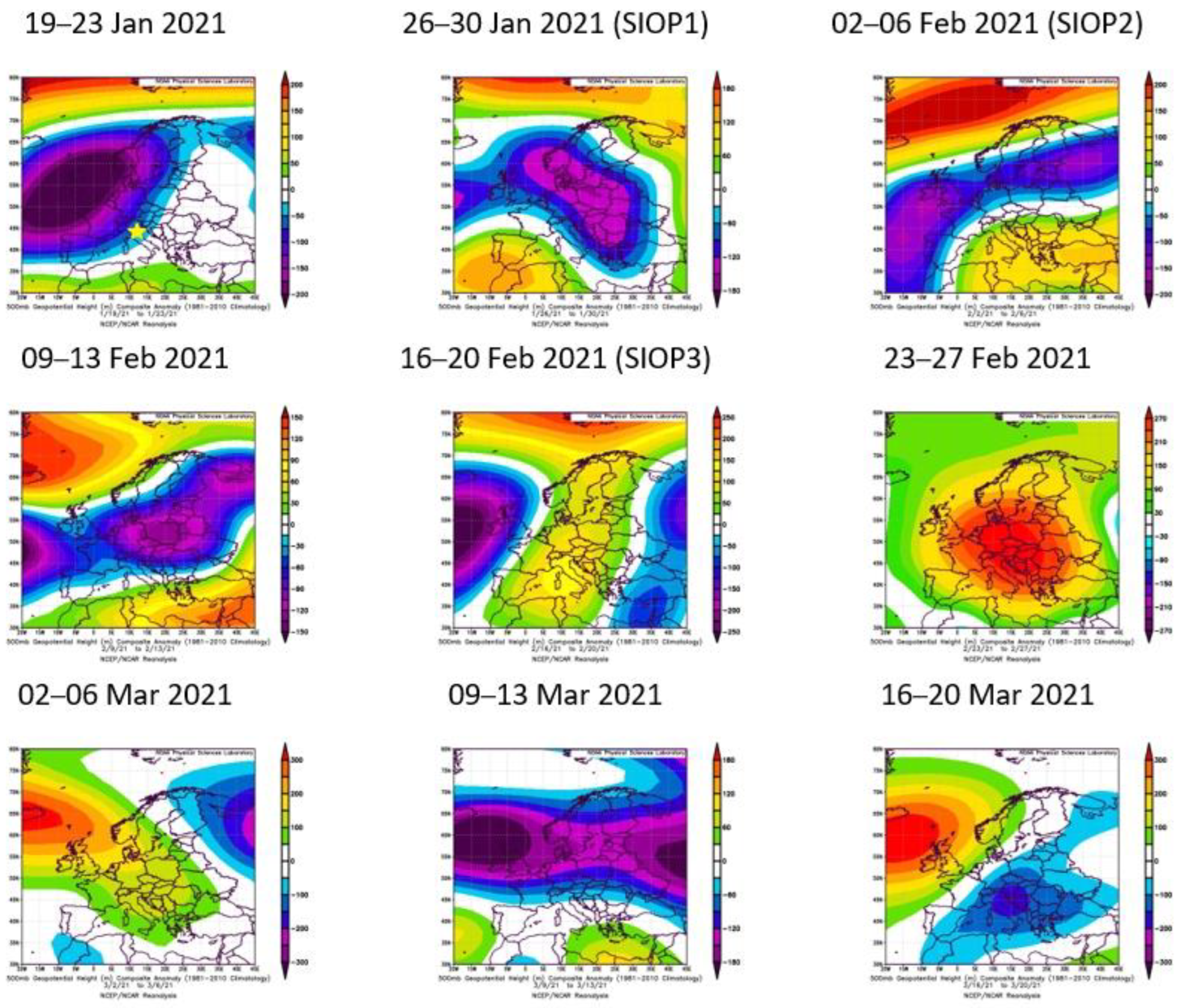
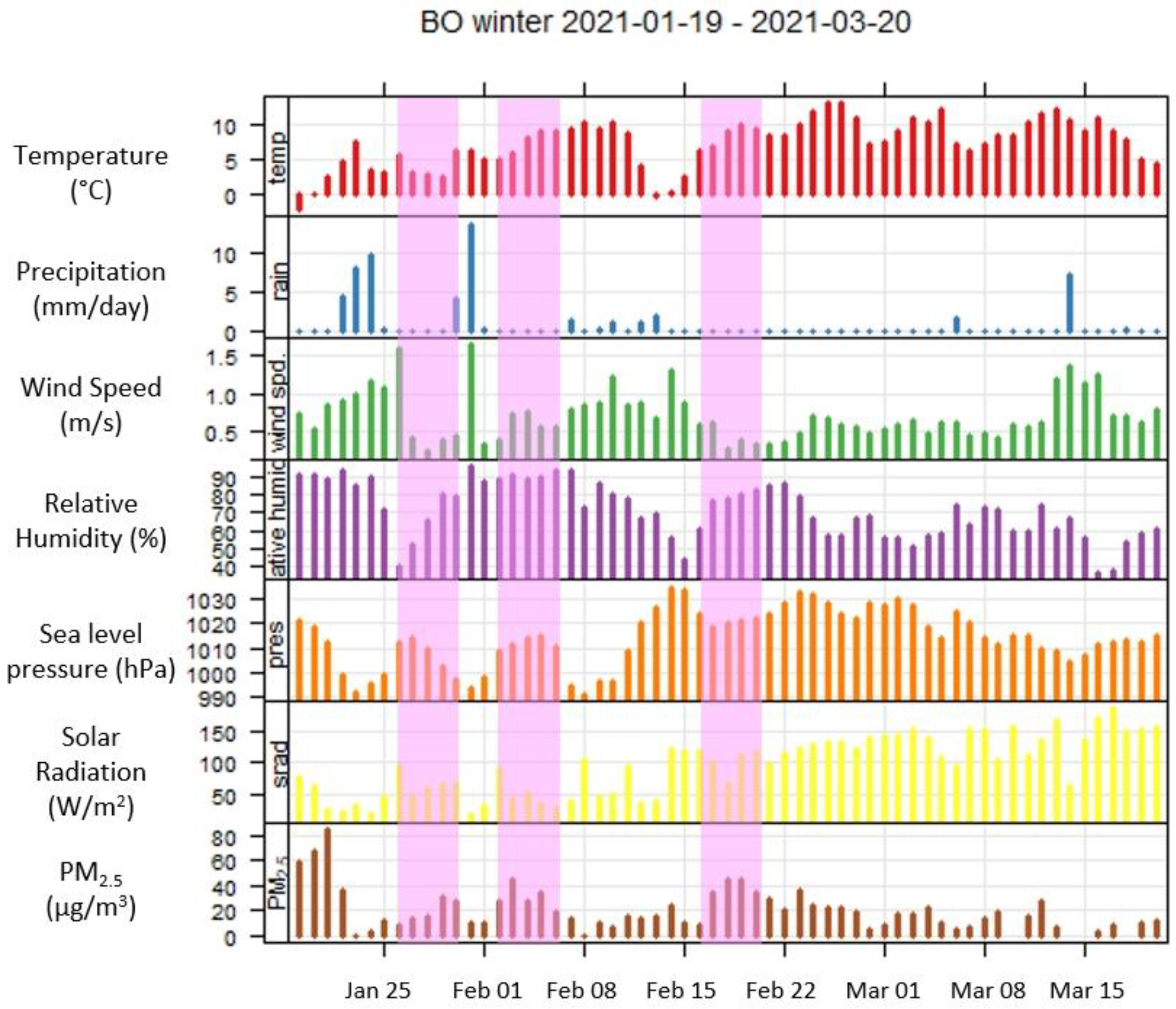
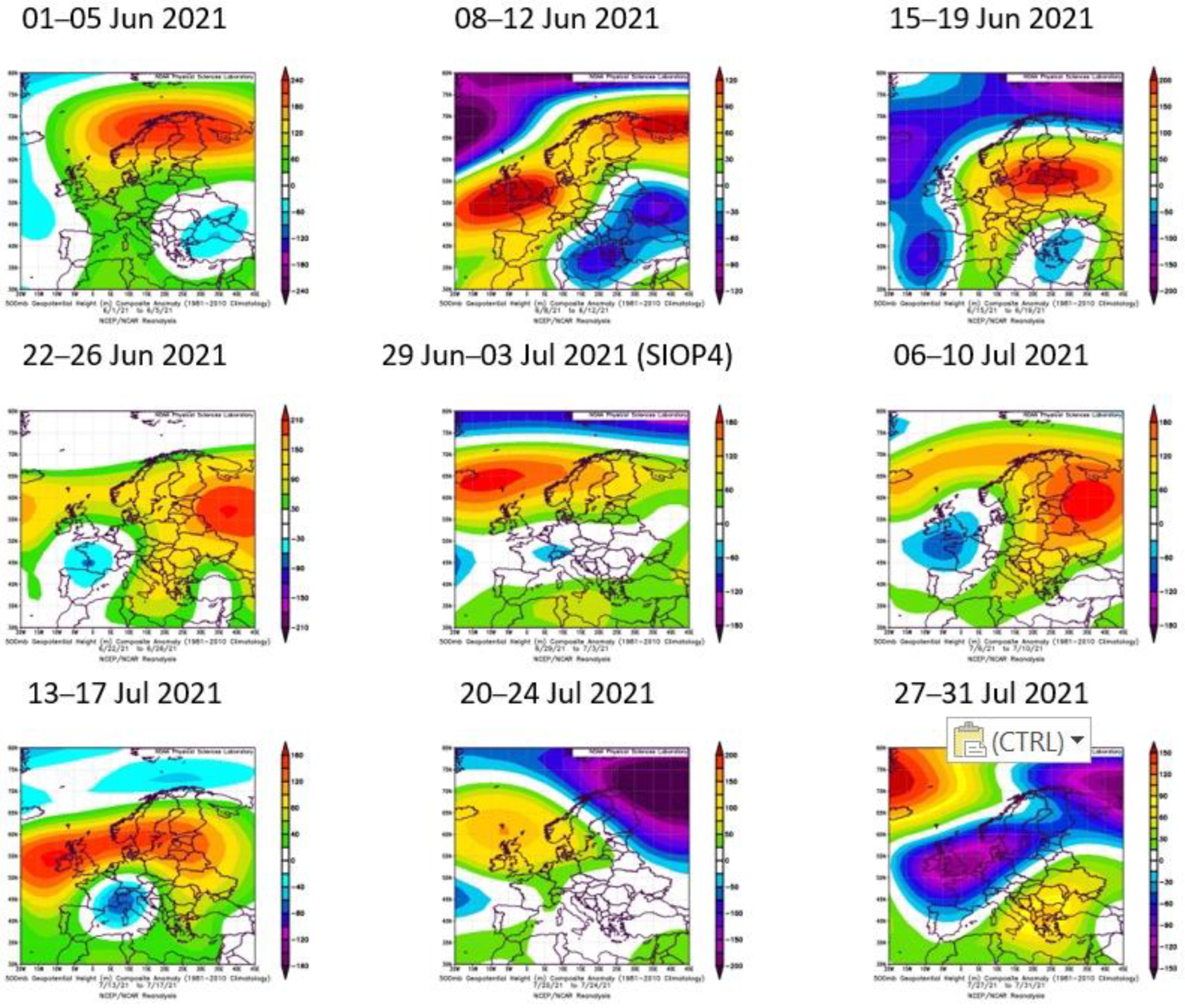
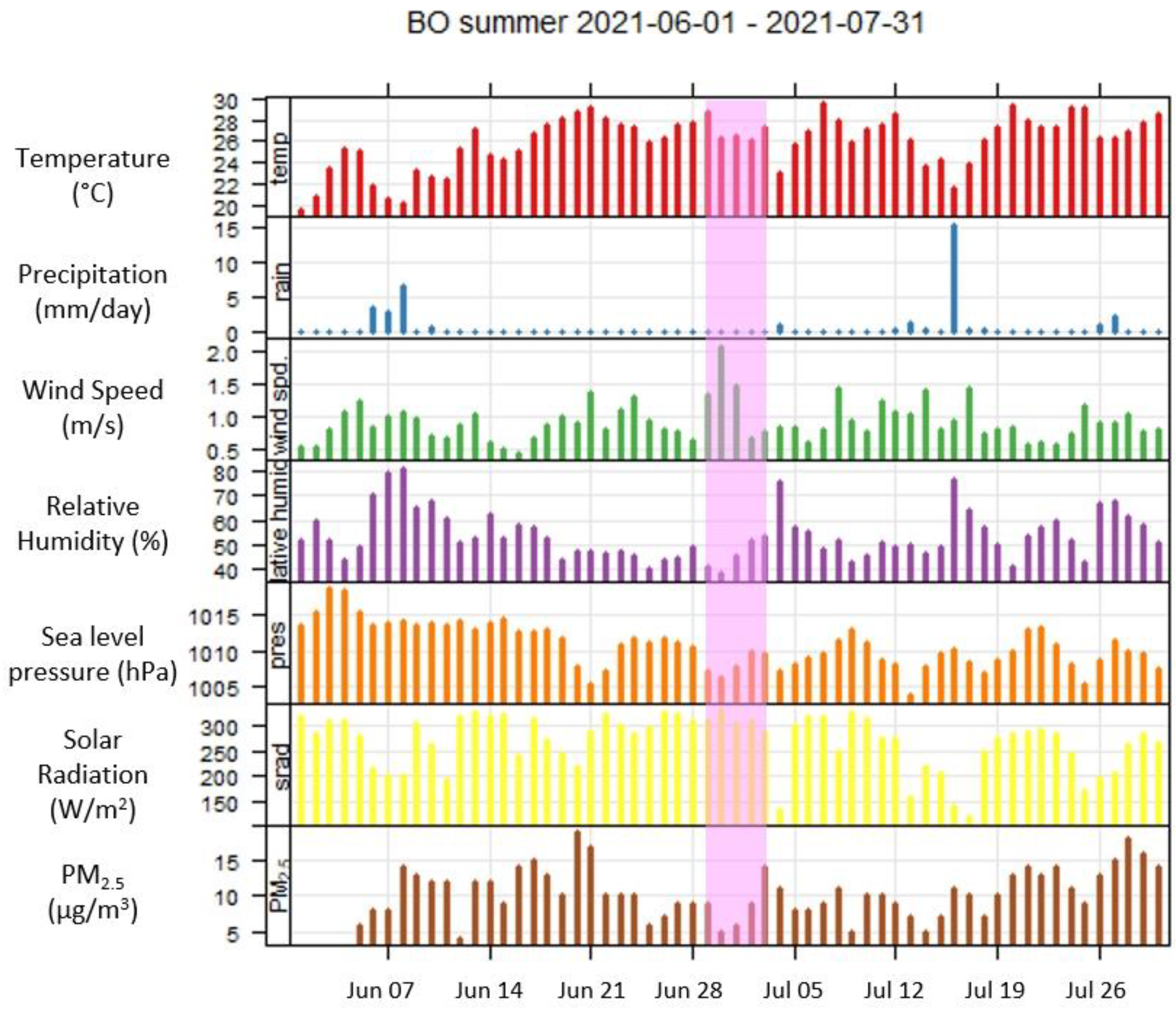
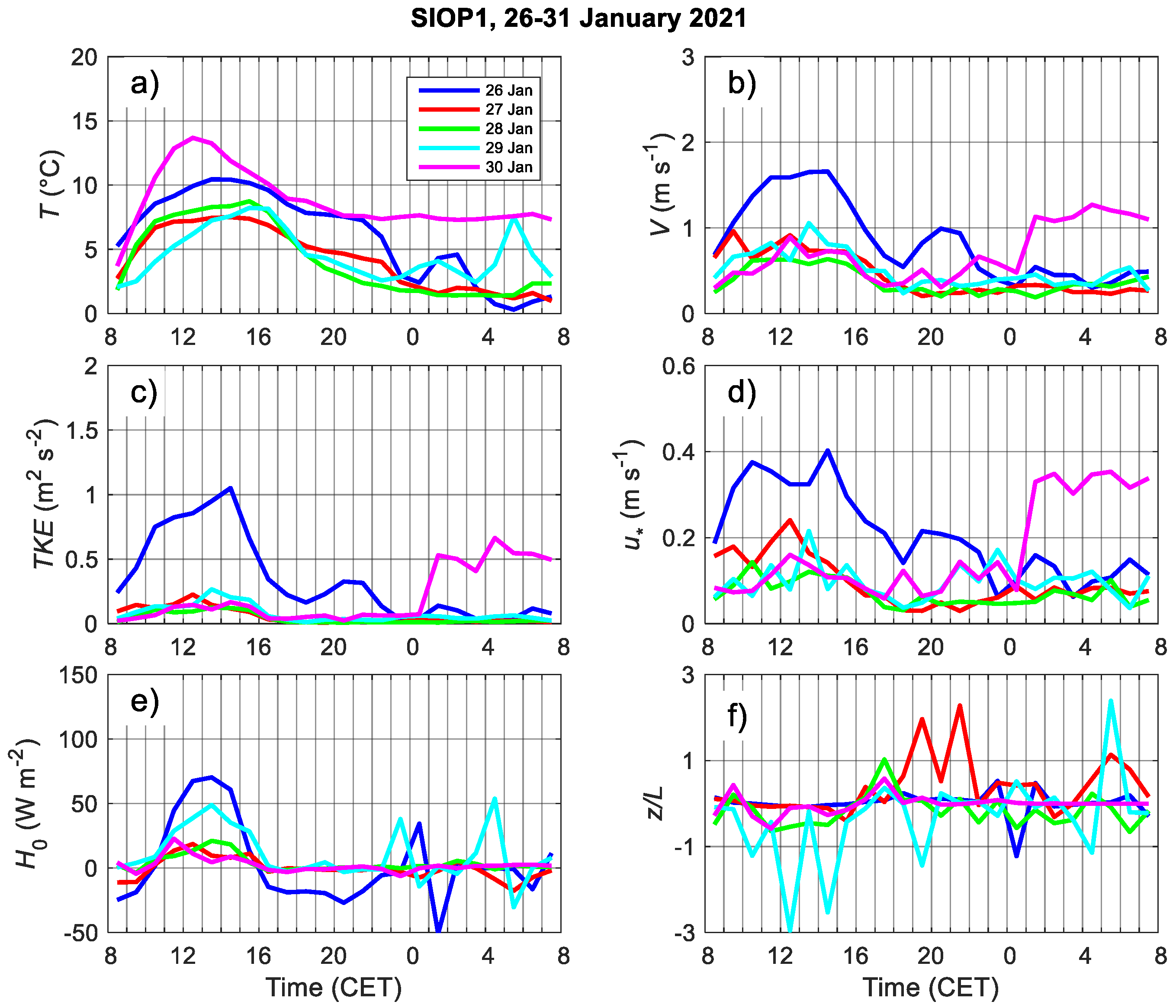



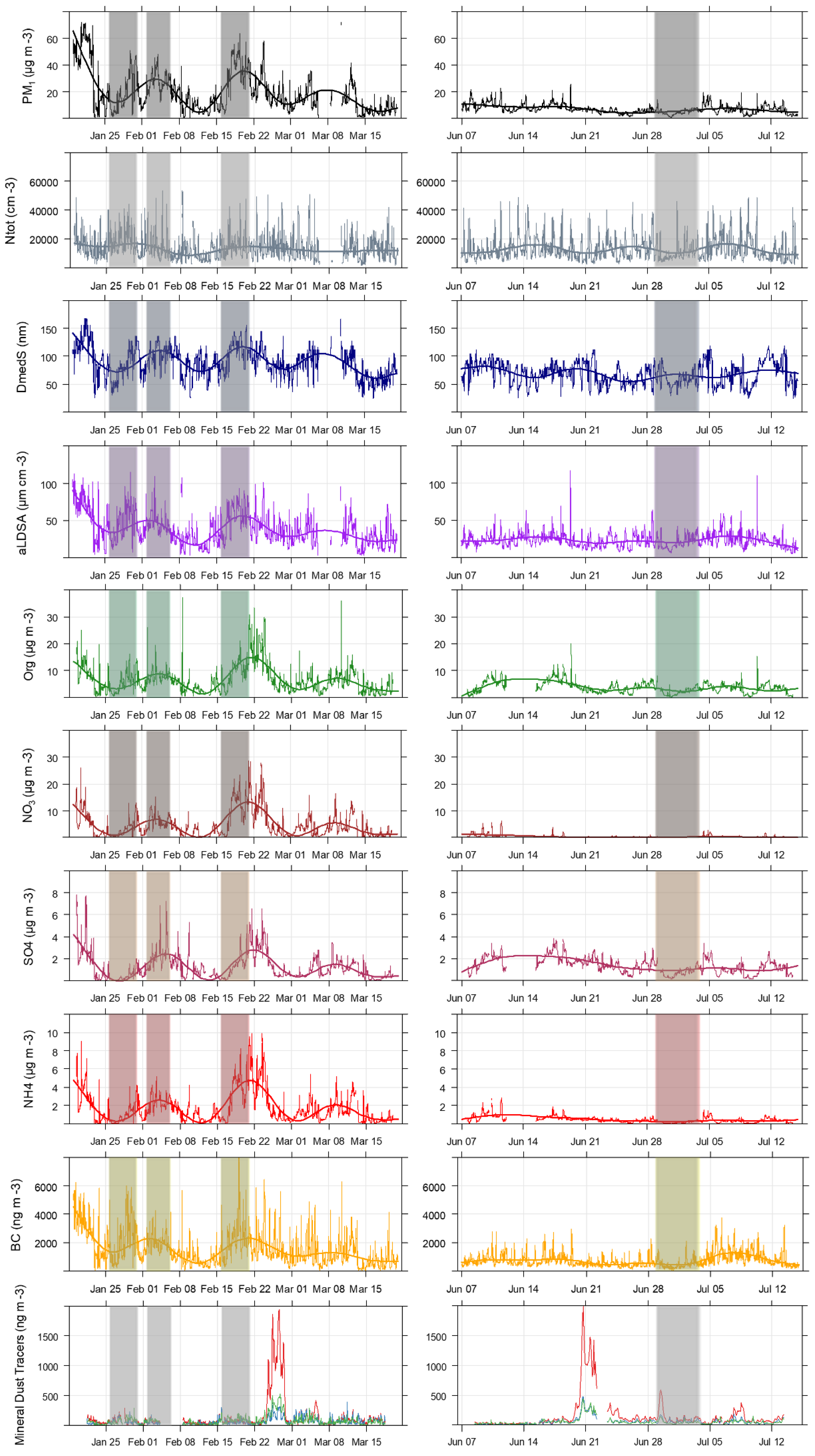


| ID | Winter | Summer |
|---|---|---|
| IOPs | 21 January 2021–18 March 2021 | 8 June 2021–14 July 2021 |
| SIOPs | 26 January 2021–3 January 2021 2 February 2021–6 February 2021 16 February 2021–20 February 2021 | 29 June 2021–2 July 2021 |
| Variables | Urban | BB | SOA/SIA | Clean |
|---|---|---|---|---|
| BC-to-PM1 | ↑ | ↓ | ||
| BC-to-OA | ↑ | ↓ | ↓ | |
| AAE (467-660) | ↓ | ↑ | ||
| Nitrate mass concentration | ↑ | ↓ | ||
| Sulfate mass concentration | ↑ | ↓ | ||
| Primary OC mass concentration | ↑ | ↑ | ||
| Secondary OC mass concentration | ↑ | |||
| Median particle diameter | ↓ | ↓ | ↑ | |
| PM1 mass concentration | ↑ | ↓ | ||
| BC mass concentration | ↓ | ↑ | ↓ | |
| Number concentration | ↑ | ↓ | ||
| Secondary formaldehyde | ↑ | |||
| Weather conditions | stable | stable | Stable, foggy | Strong winds, low pressure, no rain |
| Winter Campaign (21 January 2021–18 March 2021) | |||||
|---|---|---|---|---|---|
| Urban Background Site (BO) | |||||
| Sampler | Flowrate | Inlet | Sampling Time | Filters | Target |
| Dual channel (Dadolab Gemini) | 1.15 m3/h | Modified PM1 | 24 h from 8:00 to 08:00 LT | Quartz-fibre PTFE | Ions (by IC), levoglucosan (HPAEC-PAD) Elements (PIXE) |
| Dual channel (Dadolab Gemini) | 1.15 m3/h | Modified PM1 | 24 h from 8:00 to 08:00 LT | 2 PTFE | Toxicological assays and embryotoxicity |
| Single channel (Dadolab Giano) | 1.15 m3/h | Modified PM1 | 24 h from 8:00 to 08:00 LT | PTFE | Water soluble oxidative potential |
| Single channel (Dadolab Giano) | 1.15 m3/h | Modified PM1 | 24 h from 8:00 to 08:00 LT | PTFE | Trace metals (ICP-MS) |
| Single channel (TCR-Tecora Skypost) | 1.15 m3/h | Modified PM1 | 24 h from 8:00 to 08:00 LT | Quartz fiber | Oxidative potential—OP tot |
| STRAS | 0.5 m3/h | Modified PM1 | 1 h | Polycarbonate | 1 h resolved elements (PIXE) |
| Single channel (TCR-Tecora Skypost) | 2.3 m3/h | PM1 | 48 h from 8:00 to 08:00 LT | Pre-fired quartz fibre | 14C |
| HV sampler (TCR-Tecora) | 30 m3/h | PM1 | 24 h from 8:00 to 08:00 LT | Quartz fibre | Extra analyses |
| Rural background site (SPC) | |||||
| Dual channel (Dadolab Gemini) | 1.15 m3/h | Modified PM1 | 24 h from 8:00 to 08:00 LT | Quartz-fibre PTFE | Ions (by IC), levoglucosan (HPAEC-PAD) Elements (PIXE) |
| Dual channel (Dadolab Gemini) | 1.15 m3/h | Modified PM1 | 24 h from 8:00 to 08:00 LT | 2 PTFE | Toxicological assays and embryotoxicity |
| Dual channel (Dadolab Gemini) | 1.15 m3/h | Modified PM1 | 24 h from 8:00 to 08:00 LT | 2 PTFE | Water soluble oxidative potential Trace metals (ICP-MS) |
| Single channel (TCR-Tecora Skypost) | 1.15 m3/h | Modified PM1 | 24 h from 8:00 to 08:00 LT | Quartz fiber | Oxidative potential—OP tot |
| STRAS | 0.5 m3/h | Modified PM1 | 1 h | Polycarbonate | 1 h resolved elements (PIXE) |
| SUMMER CAMPAIGN (08 June 2021–14 July 2021) | |||||
| Urban background site (BO) | |||||
| Dual channel (Dadolab Gemini) | 2.3 m3/h | PM1 | 24 h from 8:00 to 08:00 LT | Quartz-fibre PTFE | Ions (by IC), levoglucosan (HPAEC-PAD) Elements (PIXE) |
| Dual channel (Dadolab Gemini) | 2.3 m3/h | PM1 | 24 h from 8:00 to 08:00 LT | 2 PTFE | Toxicological assays and embryotoxicity |
| Dual channel (Dadolab Gemini) | 2.3 m3/h | PM1 | 24 h from 8:00 to 08:00 LT | 2 PTFE | Water soluble oxidative potential Trace metals (ICP-MS) |
| STRAS | 0.5 m3/h | Modified PM1 | 2 h | Polycarbonate | 2 h resolved elements (PIXE) |
| Single channel (Dadolab Giano) | 2.3 m3/h | PM1 | 24 h from 8:00 to 08:00 LT | Quartz fiber | Oxidative potential—OP tot |
| Single channel (TCR-Tecora Skypost) | 2.3 m3/h | PM1 | 72 h from 8:00 to 08:00 LT | Pre-fired quartz fiber | 14C |
| HV sampler (TCR-Tecora) | 30 m3/h | PM1 | 24 h from 8:00 to 08:00 LT | Quartz fiber | Extra analyses |
| Metric | Winter (11 January 2021–31 March 2021) | Summer (27 May 2021–17 July 2021) | |||||||
|---|---|---|---|---|---|---|---|---|---|
| UoM | Mean | Std.Dev. | Median | Range (Min–Max) | Mean | Std. Dev. | Median | Range (Min–Max) | |
| PM1 | μg/m3 | 20 | 15 | 16 | 0–76 | 7 | 3 | 6 | 1–26 |
| Ntot | cm3 | 13,338 | 7441 | 11,928 | 1256–61,402 | 12,817 | 7776 | 10,586 | 2018–61,312 |
| DmedS | nm | 90 | 26 | 92 | 22–167 | 67 | 19 | 66 | 22–119 |
| a-LDSA | μm2/cm3 | 39 | 22 | 35 | 2–146 | 23 | 9 | 21 | 5–117 |
| BC | ng/m3 | 1496 | 1241 | 1163 | 6–32,275 | 677 | 456 | 551 | 33–8463 |
| OPDCFH | OPAA | OPDTT | OPDTTQRTZ | RPDPPH | |||
|---|---|---|---|---|---|---|---|
| UoM | nmol H2O2 m−3 | nmol AA min−1 m−3 | nmol DTT min−1 m−3 | nmol DTT min−1 m−3 | % Cons DPPH m−3 | ||
| MDL | 1.0 × 10−10 | 0.01 | 0.006 | 0.08 | 0.008 | ||
| BO | Winter | Mean | 4.7 × 10−9 | 0.37 | 0.91 | 0.58 | 0.42 |
| SD | 3.1 × 10−9 | 0.35 | 0.55 | 0.25 | 0.42 | ||
| Median | 4.1 × 10−9 | 0.27 | 0.83 | 0.53 | 0.33 | ||
| min–max | 1.1 × 10−10–1.2 × 10−8 | 0.018–1.9 | 0.087–2.5 | 0.15–1.1 | 0.25–1.8 | ||
| Summer | Mean | 1.6 × 10−9 | 0.47 | 0.31 | 0.22 | 0.045 | |
| SD | 1.4 × 10−9 | 0.54 | 0.17 | 0.10 | 0.087 | ||
| Median | 1.5 × 10−9 | 0.23 | 0.31 | 0.22 | 0.046 | ||
| min–max | 7.3 × 10−10–4.6 × 10−9 | 0.022–2.5 | 0.016–0.66 | 0.09–0.57 | 0.15–0.23 | ||
| SPC | Winter | Mean | 6.3 × 10−9 | 0.55 | 0.85 | 0.48 | 0.41 |
| SD | 3.9 × 10−9 | 0.82 | 0.47 | 0.23 | 0.33 | ||
| Median | 5.8 × 10−9 | 0.24 | 0.86 | 0.43 | 0.38 | ||
| min–max | 1.9 × 10−10–1.6 × 10−8 | 0.010–4.6 | 0.006–2.0 | 0.22–1.2 | 0.11–1.3 |
Publisher’s Note: MDPI stays neutral with regard to jurisdictional claims in published maps and institutional affiliations. |
© 2022 by the authors. Licensee MDPI, Basel, Switzerland. This article is an open access article distributed under the terms and conditions of the Creative Commons Attribution (CC BY) license (https://creativecommons.org/licenses/by/4.0/).
Share and Cite
Costabile, F.; Decesari, S.; Vecchi, R.; Lucarelli, F.; Curci, G.; Massabò, D.; Rinaldi, M.; Gualtieri, M.; Corsini, E.; Menegola, E.; et al. On the Redox-Activity and Health-Effects of Atmospheric Primary and Secondary Aerosol: Phenomenology. Atmosphere 2022, 13, 704. https://doi.org/10.3390/atmos13050704
Costabile F, Decesari S, Vecchi R, Lucarelli F, Curci G, Massabò D, Rinaldi M, Gualtieri M, Corsini E, Menegola E, et al. On the Redox-Activity and Health-Effects of Atmospheric Primary and Secondary Aerosol: Phenomenology. Atmosphere. 2022; 13(5):704. https://doi.org/10.3390/atmos13050704
Chicago/Turabian StyleCostabile, Francesca, Stefano Decesari, Roberta Vecchi, Franco Lucarelli, Gabriele Curci, Dario Massabò, Matteo Rinaldi, Maurizio Gualtieri, Emanuela Corsini, Elena Menegola, and et al. 2022. "On the Redox-Activity and Health-Effects of Atmospheric Primary and Secondary Aerosol: Phenomenology" Atmosphere 13, no. 5: 704. https://doi.org/10.3390/atmos13050704











